Samsung Galaxy S 4 Review - Part 1
by Brian Klug on April 24, 2013 12:01 AM ESTDisplay
We wrote about how we suspected that SGS4 would go to a 5-inch 1080p SAMOLED display just after CES. Turns out that was spot on, as the SGS4 includes a 5-inch 1080p Full HD SAMOLED panel, the latest in Samsung's AMOLED roadmap. Samsung's naming stays true, and there's no Plus tacked on at the end, so we get another non-RGB stripe subpixel geometry with SGS4. The last few Samsung AMOLED variants we've seen have had different subpixel grids, and the one on the SGS4 is possibly the most interesting to date. There's still a bias toward more green subpixels than blue or red, this isn't an RGB stripe at all, but instead of the previous RG,BG layout we see this offset pattern with green on one line, then blue and red on another line. Interestingly enough the blue subpixel appears to be a square, and red and green appear to be circles, with the difference in area possibly offsetting the luminous efficiency of each material. Whatever the reason (Samsung has never been official or forthcoming any of these subpixel patterns each time they've changed them) it's present on the SGS4.
At this size however I have to admit that I find the pursuit of the subpixel geometry more of an educational one than something which affects users. While I could occasionally see it on the SGS3, I definitely do not see it on SGS4. The subpixels are now small enough that whatever the pattern, it all looks like a homogenous light-emitting surface, which was the goal after all. I could bring up the visual acuity discussion again but just trust me that it's small enough to not be visible even with actually perfect (not legally perfect, which is different) vision.
So resolution is great and up to par with all the other LCD-bearing flagships this year, lack of RGB stripe notwithstanding. There's that remaining question about brightness, contrast, outdoor visibility, and of course calibration and the saturation issue that has persisted with AMOLED from generation to generation.
On the brightness front, the SGS4 includes dynamic contrast functions that cannot be disabled and change as a function of what is being displayed. There's an "auto adjust screen tone" checkbox under display but don't let that fool you, that doesn't disable dynamic contrast, just white point. Under screen mode are the mDNIe toggles we've seen on countless other previous Samsung Android phones with AMOLED panels, only here we notice something interesting. There have always been four toggles as long as this option has existed, only what's different is now, one of them is named "Professional photo." Reviews of other regional variants of the SGS4 have included the same button but marked "Adobe RGB." Oddly enough it seems that the North American versions at least have this renamed for some reason, but undoubtedly the function is the same. Many speculated that this is now a toggle for some full CMS (Color Management System) which "fixes" the inherent color space issues with AMOLED and oversaturation that occurs when looking at sRGB content on such devices. Unfortunately, I can confirm that my initial suspicions that this is just a continuation of the mDNIe (lite) settings from previous generation is in fact correct. I reverse engineered what I could of these settings from both kernel messages while changing the toggles, and looking at the kernel sources. Turns out that 'Professional photo' mode is actually the 'Natural' mode renamed from previous versions.
So the question was whether the color space or white point actually does change with this mode enabled. I ran the SGS4 through our display tests in each of the modes and think the full color space plot tells the story. The sanest of them all really ends up being the strangely-named 'Movie' mode. Professional photo gives the big gamut with a white point closer to 'Movie,' which is to say around 7000K, but it doesn't fundamentally change the still-present oversaturation or color management issue that exists in Android with these wide gamut displays. Most users admittedly don't care however and just see "bright" colors. Theres' an Auto mode as well which the device ships with that basically has a matrix of mDNIe settings for targeted applications (for example the Gallery, Browser, Video playback) and so forth get settings, which you can see in the kernel.
| CalMAN Display Comparison | ||||||||||||
| Metric | iPhone 5 | iPhone 4S | HTC One X | SGS3 | Samsung Galaxy Note 2 | Google Nexus 4 | HTC Droid DNA | HTC One | SGS4 | |||
| Grayscale 200nits Avg dE2000 | 3.564 | 6.162 | 6.609 | 4.578 | 5.867 | 7.686 | 6.738 | 5.391 | 7.511 | |||
| CCT Avg (K) | 6925 | 7171 | 5944 | 6809 | 7109 | 8506 | 8108 | 8118 | 7020 | |||
| Saturation Sweep Avg dE2000 | 3.591 | 8.787 | 5.066 | 5.460 | 7.986 | 8.517 | 5.856 | 3.365 | 7.823 | |||
| GMB ColorChecker Avg dE2000 | 4.747 | 6.328 | 6.963 | 7.322 | 8.185 | 7.531 | 6.687 | 4.656 | 7.440 | |||
In the "Movie" mode things are better controlled than the Note 2 on the GMB color checker card test, which is the most important one for me. White point is also no longer the crazy 8000K that we saw before, 7000K is commendable for Samsung at this point. Keep in mind that maximum brightness changes in each mode as well as we effectively clamp things, I measured a maximum of 319 nits in Dynamic mode, 311 nits in Movie mode, and 255 nits in Standard, for example.
Running the display at maximum brightness for too long will also get you into an overheating or thermal protection mode as well, which we've seen on countless other AMOLED variants. Most of the time I suspect users will run on Auto brightness however which keeps brightness down to a much lower level to save battery and prevent that from becoming a problem.
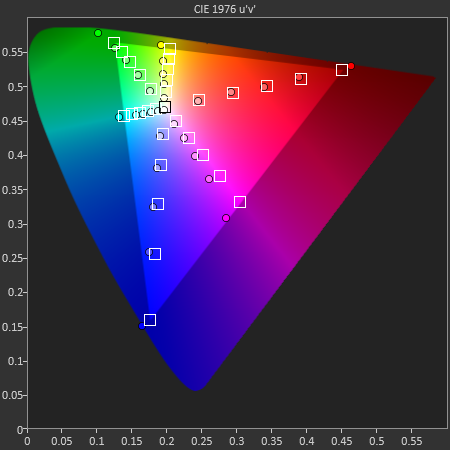
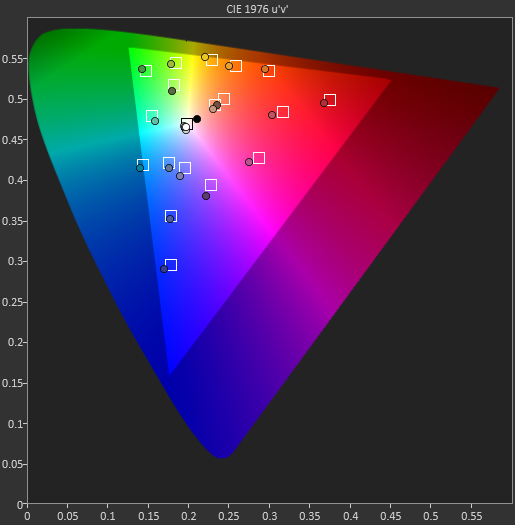
Because "Movie" was the closest to sRGB of all the modes, I selected it for the actual results that I'll present in the table. Admittedly this mode does tighten things up a bit, but it still isn't perfect and I'd still like to see Samsung do something to reign this in at some point.


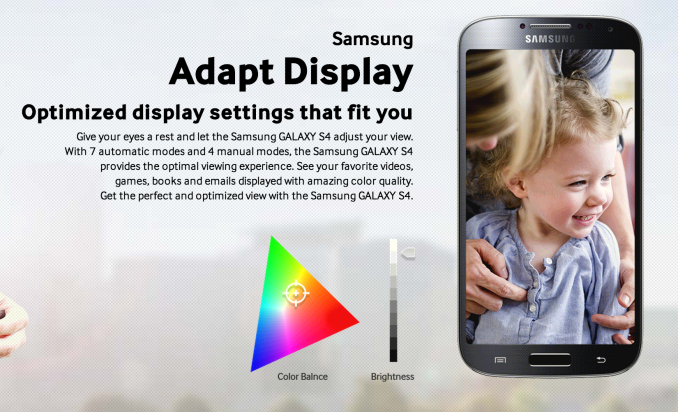




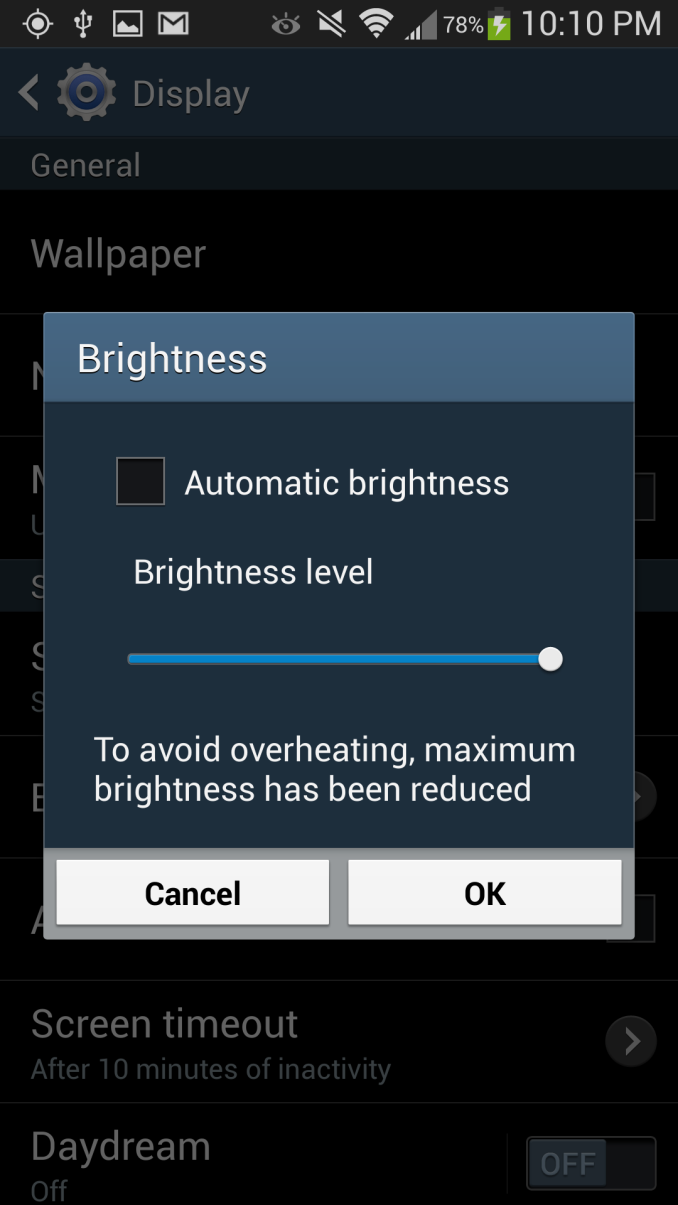
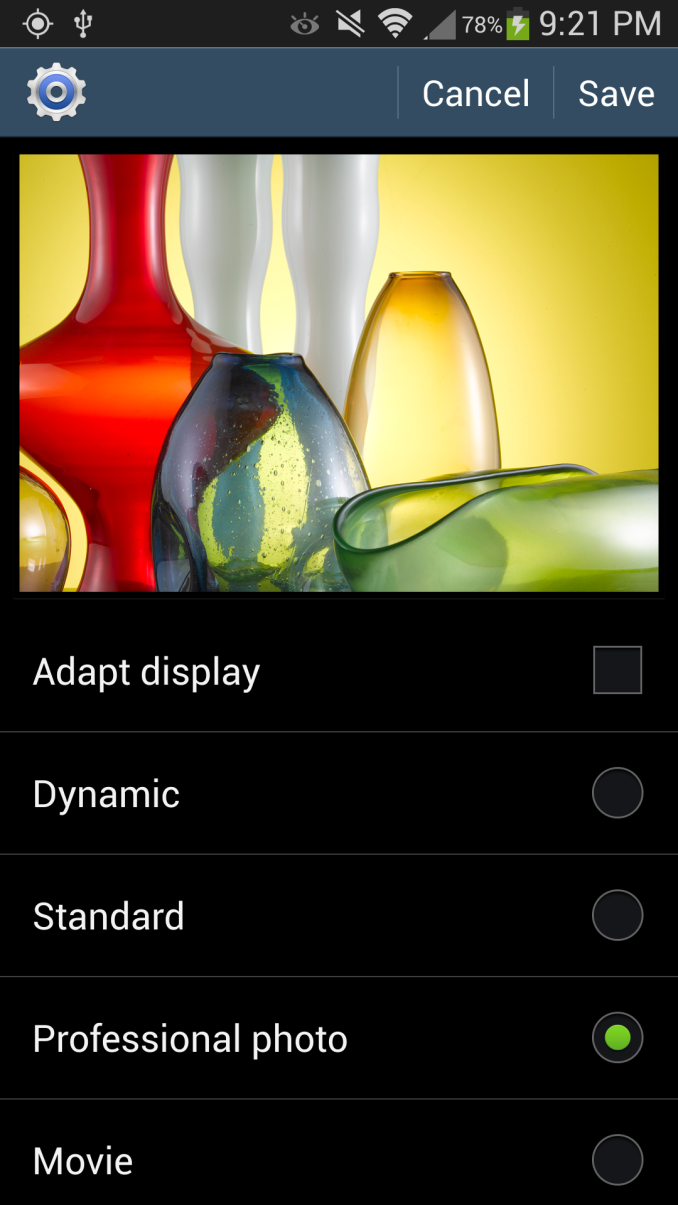
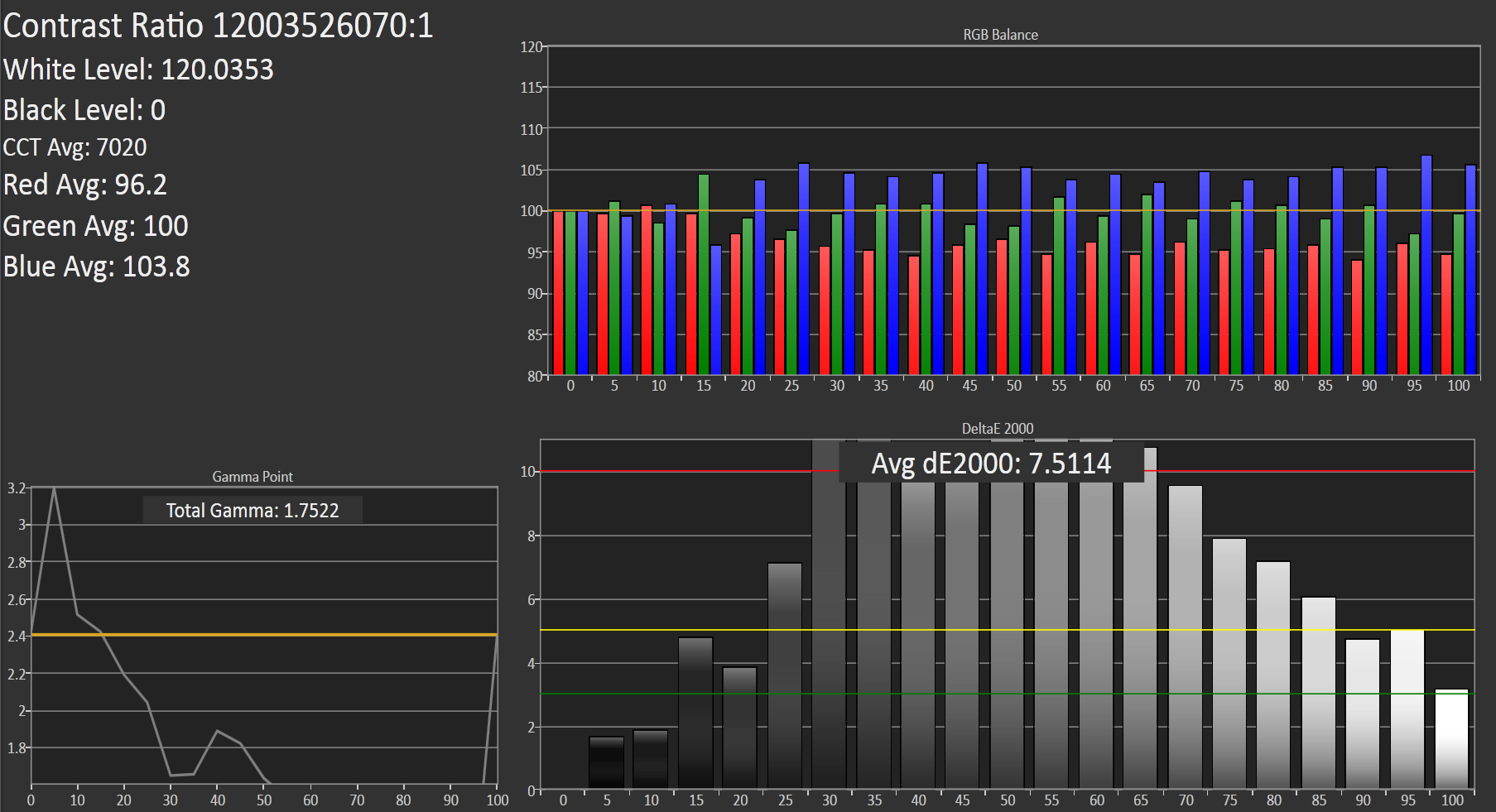








335 Comments
View All Comments
heleymartin88 - Monday, April 29, 2013 - link
</b><a href="http://is.gd/tDlFss">The bettel between android smartphone begin now.From hands-free gesture controls to a “photobomb”-erasing feature, here’s why you’ll want the Samsung Galaxy S4.6 Reasons to get the Samsung Galaxy S4.....</a></b>heleymartin88 - Monday, April 29, 2013 - link
From hands-free gesture controls to a “photobomb”-erasing feature, here’s why you’ll want the Samsung Galaxy S4.6 Reasons to get the Samsung Galaxy S4 check out..... http://is.gd/tDlFssMugur - Monday, April 29, 2013 - link
Brian, can you please have a head to head comparison between the Exinos and Qualcomm variants of the S4? I am really curios whether the Octa really means something in terms of battery and performance...1ndian - Monday, April 29, 2013 - link
I think, Samsung's design is more repairable. So, for most of the people, its design is practical, easily repairable, makes the parts cheap and longer availability of parts compared to other phones... Yes they could have offered a better hardware design. But the amount of useful customization on the software side cannot be overlooked. I think software is the way to go because the hardware by itself is basically useless. Samsung's is the most customized OS in the android market. And, that hasn't affected the device's battery life or performance is a great achievement. So, as much as I hate the look of the phone... I will have to say the cost of the phone is worth it. Just for argument sake, how much do you think iPhone or SZ would cost with as many features as S4?sAiyAnstAr - Thursday, May 2, 2013 - link
If the build quality is good, then it wouldn't need to be repaired.mandywong - Monday, April 29, 2013 - link
Galaxy S 4 is an amalgamation of various cutting-edge smartphone advancements and features of today - http://bit.ly/11vUzb3SmileyDT - Monday, April 29, 2013 - link
Soon i will have it in my hands but once more the back cover is not the best and you can't use it withaout a case.. One drop and you have to search your pockets very deep! I'am looking for S4 cases and so far i have found only http://www.caseutopia.com to order some protection cases... better be safe than sorry. I hope someday samsung will produce smartphones with stronger materials. This is the only negative i find on this phone everything else is cool!MidianSpawned - Monday, April 29, 2013 - link
Whaa Plastic... Whaa aluminum... Noooo HTC is best... Nut uh Samsung is better... Ya know what.. I have a Galaxy Note 2, am very happy with it. Get whatever phone suits you best, but before you buy, know this... Not a single phone out there tastes as good as, or, looks as good as pussy... Pussy, because any phone can order a pizza. That is all!rauelius - Monday, April 29, 2013 - link
If you compare them, please remember to mention that the Galaxy S4 only offers 9GB of storage for Apps(SD-Cards don't do anything to increase storage for most functions) where as the HTC One offers 25GB for available storage. Music and Pictures can be streamed/uploaded via the Cloud and those are the only two things that the SD-Card really will do for the Galaxy S4. With games getting bigger and bigger and Google Music streaming the minuscule amount of storage on the Galaxy S4 makes the phone feel pointless combined with the excellent underlying hardware. It's like having a Ferrari with a Lawnmower's gastank, where as the HTC One is a Lamborghini with an actual gastank.Dug - Monday, April 29, 2013 - link
I'll admit I got the One for the looks and the camera. But I've found I really like Sense5 and Blinkfeed. Before I got it I thought I would never use it, now I use it constantly. There's a lot about touchwiz I don't like. All personal preference though.